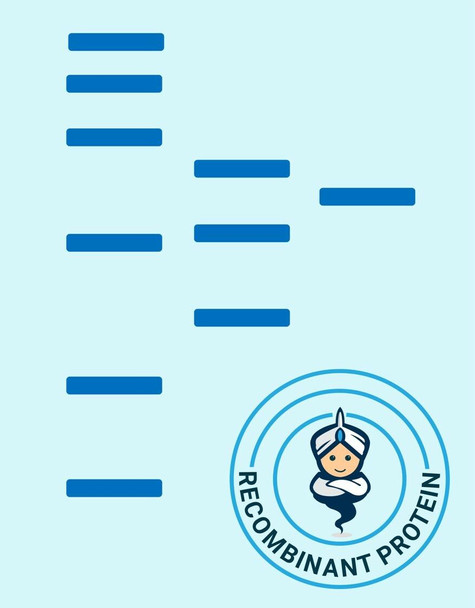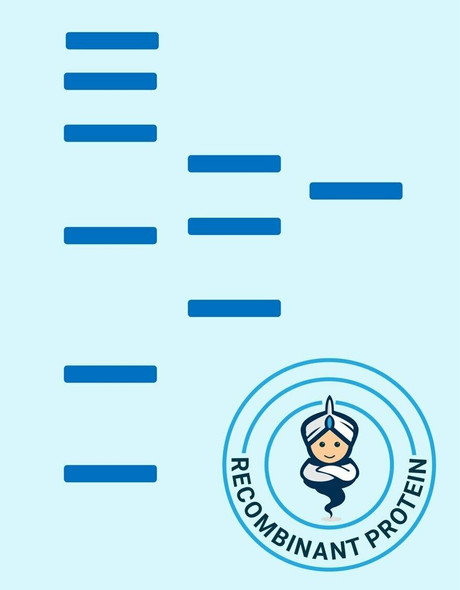Human PVR Recombinant Protein (RPPB4340)
- SKU:
- RPPB4340
- Product type:
- Recombinant Protein
- Size:
- 5ug
- Species:
- Human
- Target:
- PVR
- Synonyms:
- Poliovirus receptor
- Nectin-like protein 5
- NECL-5
- CD155
- Source:
- Sf9 Insect cells
- Uniprot:
- P15151
Description
| Product Name: | Human PVR Recombinant Protein |
| Product Code: | RPPB4340 |
| Size: | 5µg |
| Species: | Human |
| Target: | PVR |
| Synonyms: | Poliovirus receptor, Nectin-like protein 5, NECL-5, CD155, PVR, PVS. |
| Source: | Sf9 Insect cells |
| Physical Appearance: | Sterile Filtered colorless solution. |
| Formulation: | PVR protein solution (1mg/ml) contains Phosphate Buffered Saline (pH 7.4) and 10% glycerol. |
| Stability: | Store at 4°C if entire vial will be used within 2-4 weeks. Store, frozen at -20°C for longer periods of time. For long term storage it is recommended to add a carrier protein (0.1% HSA or BSA). Avoid multiple freeze-thaw cycles. |
| Purity: | Greater than 90.0% as determined by SDS-PAGE. |
| Amino Acid Sequence: | WPPPGTGDVV VQAPTQVPGF LGDSVTLPCY LQVPNMEVTH VSQLTWARHG ESGSMAVFHQ TQGPSYSESK RLEFVAARLG AELRNASLRM FGLRVEDEGN YTCLFVTFPQ GSRSVDIWLR VLAKPQNTAE VQKVQLTGEP VPMARCVSTG GRPPAQITWH SDLGGMPNTS QVPGFLSGTV TVTSLWILVP SSQVDGKNVT CKVEHESFEK PQLLTVNLTV YYPPEVSISG YDNNWYLGQN EATLTCDARS NPEPTGYNWS TTMGPLPPFA VAQGAQLLIR PVDKPINTTL ICNVTNALGA RQAELTVQVK EGPPSEHSGM SRNLEHHHHH H |
Poliovirus receptor, also known as PVR, is a Type I transmembrane glycoprotein which belongs to the immunoglobulin superfamily. PVR catalyzes a big structural modification in the virus which exposes membrane-binding protein chains. PVR regulates helper T cell differentiation as well as allergic diseases. PVR is expressed in many kinds of human cells and has various functions. PVR is potentially functional as a biomarker for cancer development as well as progression. PVR takes a vital part through both immunological & non-immunological mechanisms in pancreatic cancer.
PVR Human Recombinant produced in Sf9 Insect cells is a single, glycosylated polypeptide chain containing 331 amino acids (21-343 a.a.) and having a molecular mass of 36.1kDa (Molecular size on SDS-PAGE will appear at approximately 40-57kDa). PVR is expressed with an 8 amino acids His tag at C-Terminus and purified by proprietary chromatographic techniques.
| UniProt Protein Function: | PVR: Mediates NK cell adhesion and triggers NK cell effector functions. Binds two different NK cell receptors: CD96 and CD226. These interactions accumulates at the cell-cell contact site, leading to the formation of a mature immunological synapse between NK cell and target cell. This may trigger adhesion and secretion of lytic granules and IFN-gamma and activate cytoxicity of activated NK cells. May also promote NK cell-target cell modular exchange, and PVR transfer to the NK cell. This transfer is more important in some tumor cells expressing a lot of PVR, and may trigger fratricide NK cell activation, providing tumors with a mechanism of immunoevasion. Plays a role in mediating tumor cell invasion and migration. Serves as a receptor for poliovirus attachment to target cells. May play a role in axonal transport of poliovirus, by targeting virion-PVR-containing endocytic vesicles to the microtubular network through interaction with DYNLT1. This interaction would drive the virus-containing vesicle to the axonal retrograde transport. Belongs to the nectin family. 4 isoforms of the human protein are produced by alternative splicing. |
| UniProt Protein Details: | Protein type:Membrane protein, integral; Receptor, misc.; Motility/polarity/chemotaxis; Immunoglobulin superfamily Chromosomal Location of Human Ortholog: 19q13.2 Cellular Component: extracellular space; focal adhesion; cell surface; cytoplasm; integral to membrane; plasma membrane Molecular Function:viral receptor activity; protein binding; receptor activity; cell adhesion molecule binding Biological Process: intercellular junction assembly and maintenance; entry of virus into host cell; cell-cell adhesion; cell migration; regulation of immune response; positive regulation of natural killer cell mediated cytotoxicity directed against tumor cell target; response to virus; susceptibility to natural killer cell mediated cytotoxicity; positive regulation of natural killer cell mediated cytotoxicity |
| NCBI Summary: | The protein encoded by this gene is a transmembrane glycoprotein belonging to the immunoglobulin superfamily. The external domain mediates cell attachment to the extracellular matrix molecule vitronectin, while its intracellular domain interacts with the dynein light chain Tctex-1/DYNLT1. The gene is specific to the primate lineage, and serves as a cellular receptor for poliovirus in the first step of poliovirus replication. Multiple transcript variants encoding different isoforms have been found for this gene. [provided by RefSeq, Oct 2008] |
| UniProt Code: | P15151 |
| NCBI GenInfo Identifier: | 1346922 |
| NCBI Gene ID: | 5817 |
| NCBI Accession: | P15151.2 |
| UniProt Secondary Accession: | P15151,P15152, Q15267, Q15268, Q96BJ1, B4DTS9, |
| UniProt Related Accession: | P15151 |
| Molecular Weight: | Observed MW: 70kDaCalculated MW: 39kDa/40kDa/42kDa/45kDa |
| NCBI Full Name: | Poliovirus receptor |
| NCBI Synonym Full Names: | poliovirus receptor |
| NCBI Official Symbol: | PVR |
| NCBI Official Synonym Symbols: | PVS; HVED; CD155; NECL5; TAGE4; Necl-5 |
| NCBI Protein Information: | poliovirus receptor; nectin-like protein 5 |
| UniProt Protein Name: | Poliovirus receptor |
| UniProt Synonym Protein Names: | Nectin-like protein 5; NECL-5; CD_antigen: CD155 |
| Protein Family: | Poliovirus receptor |
| UniProt Gene Name: | PVR |
| UniProt Entry Name: | PVR_HUMAN |








